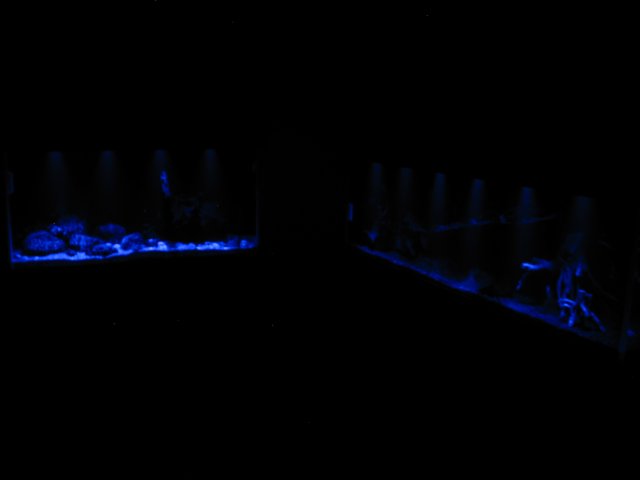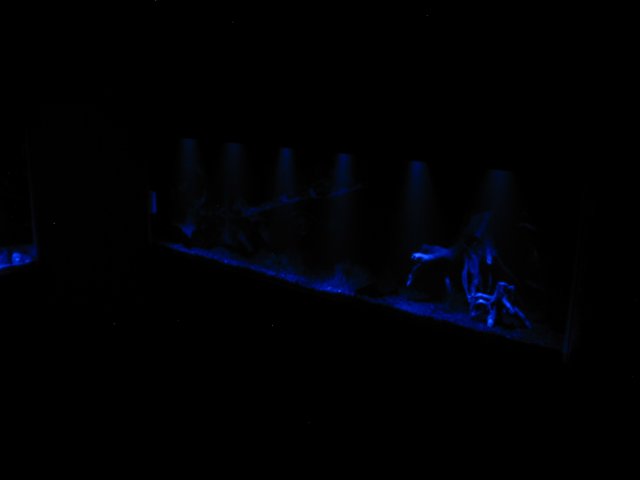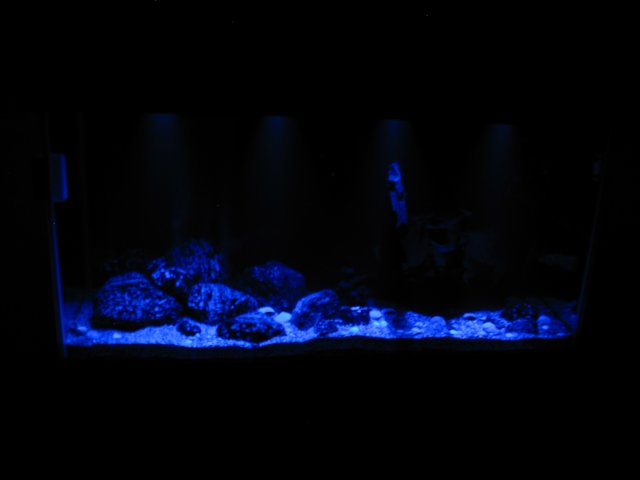New shots... SE Asian and African biotope tanks
- Thread starter DrNo
- Start date
You are using an out of date browser. It may not display this or other websites correctly.
You should upgrade or use an alternative browser.
You should upgrade or use an alternative browser.
Lots of stem plants have medial roots to both extract nutrients from the water more effectively and reach out for other areas of sustrate to hold them down. The only way to deal with them is to cut off the plant near the top of the roots, throw away the bottom (or transplant it to the back of the thicket), and replant the top.
Here's an Amano Trick for you: Stick a half dozen or a dozen Crypts (wendtii or Undulata) between the Hygro and the grass on one side, and the rotala and the grass on the other. They're in biotope, grow fairly slowly, and will screen the bottom of the stems, so as they get leggy it won't skew your aquascape. Looks really nice if you use the Red, Bronze, or Mi Oya varieties of C. wendtii.
wow what a great job on those tanks, keep it up. im curious to see how it looks when the plants fill in.
Great suggestion tophat... thanks! I wonder about room however as the dwarf grasses are filling in quickly.
Thanks jaysen. Like everyone's tank, they always seem te be a work in progress and their character changes as the plants grow. Next project for me is getting more dwarf anubia for the African tank (and the schooling zebras for Asia).
Thanks jaysen. Like everyone's tank, they always seem te be a work in progress and their character changes as the plants grow. Next project for me is getting more dwarf anubia for the African tank (and the schooling zebras for Asia).
Last edited:
Some night shots. I really need to invest in a tripod...


The black substrate in Asia means the blue LED's don't have much to reflect off of; the result is muted coloring. The one thing you can see under this LED lighting is the extent of the cataracts in the old-man ID Shark! Given the conditions he lived in for nearly 10 years (prior to me assuming his care), I have to wonder how compressed his life-span is going to be.
I've found that examining the fish under this blue lighting is an excellent way to check for any diseases that manifest as white patches/discoloration. Even a handheld blue LED with the room and tank lights off will highlight any white areas on your fish.

The white/black substrate and the white flecks in the obsidian make the Tanganyika tank more striking using the exact same LEDs.... the wife's favorite.





The black substrate in Asia means the blue LED's don't have much to reflect off of; the result is muted coloring. The one thing you can see under this LED lighting is the extent of the cataracts in the old-man ID Shark! Given the conditions he lived in for nearly 10 years (prior to me assuming his care), I have to wonder how compressed his life-span is going to be.
I've found that examining the fish under this blue lighting is an excellent way to check for any diseases that manifest as white patches/discoloration. Even a handheld blue LED with the room and tank lights off will highlight any white areas on your fish.

The white/black substrate and the white flecks in the obsidian make the Tanganyika tank more striking using the exact same LEDs.... the wife's favorite.



Some relatively big changes coming very soon to both tanks.
Lake Tanganyika: I've decided to add a school of ~6-8 larger schooling cyps (blue flash, etc.) to the tank to add more mid-tank interest, and am increasing the density of the anubias nana for the focal vegetation display. In additon, I'll be introducing 2 small synodontis nigriventus (Upside downs)to aid in detris removal. The arching driftwood has a great 'cave' effect directly in front, and I suspect the cats will be visible to observers even during the daytime as they rest. The Gold Head Comps are thriving and growing (albeit slowly). With the present bichir, this will conclude stocking.
SE Asia: I've removed the java fern (impatience with lack of robust growth) and the crinum as they never really thrived for me. Instead, I'm introducing some green wendtii crypts and the school of zebra danios for tank dither (if DrFosterSmith would ever get them in stock).
Updated pics to follow.
Lake Tanganyika: I've decided to add a school of ~6-8 larger schooling cyps (blue flash, etc.) to the tank to add more mid-tank interest, and am increasing the density of the anubias nana for the focal vegetation display. In additon, I'll be introducing 2 small synodontis nigriventus (Upside downs)to aid in detris removal. The arching driftwood has a great 'cave' effect directly in front, and I suspect the cats will be visible to observers even during the daytime as they rest. The Gold Head Comps are thriving and growing (albeit slowly). With the present bichir, this will conclude stocking.
SE Asia: I've removed the java fern (impatience with lack of robust growth) and the crinum as they never really thrived for me. Instead, I'm introducing some green wendtii crypts and the school of zebra danios for tank dither (if DrFosterSmith would ever get them in stock).
Updated pics to follow.
Last edited:
Sounds like a plan, fleshing out the anubias. If you can lay hands on smallish rocks, what works well (according to Amano-san) is to attach your epiphytes to small rocks then tuck the rocks into hollows in the driftwood.
Something I have been thinking about is to get some of those washer shaped stone beads, use those as anchors for the plants, and then screw them to the driftwood with brass or stainless screws through the holes. Course, you could probably just skip the beads and use screws, but where's the fun in that?
Java Fern takes lots of patience, I have found. I am just now, after 2 years, getting some acceptable growth on the ferns in my 75.
Something I have been thinking about is to get some of those washer shaped stone beads, use those as anchors for the plants, and then screw them to the driftwood with brass or stainless screws through the holes. Course, you could probably just skip the beads and use screws, but where's the fun in that?
Java Fern takes lots of patience, I have found. I am just now, after 2 years, getting some acceptable growth on the ferns in my 75.


